Chapter Six in The Northumbrian Kiap is titled “A bonfire of spears and arrows”.
This optimistic update includes a postscript which, among many other things, underlines the speed of Papua New Guinea’s educational advancement after Independence.
It also demonstrates that internal solutions to what might otherwise have remained near interminable inter-clan arguments over a disputed area of land could, with diligence and imagination, be constructed.
Intense fighting between neighbouring clans in the Minj Sub-District of PNG’s Western Highlands over an awkward land boundary had flared in 1972.
The armed struggle between the Wahgi Valley’s Tangilka and Kamblika clans was triggered by a murder. Retaliation by the aggrieved brotherhood included rape, systematic theft, and arson.
It was resolved in two distinct stages:
# A temporary truce was confirmed on April 22nd 1972 when each clan stacked its spears and arrows in the market place at Minj and burned them.
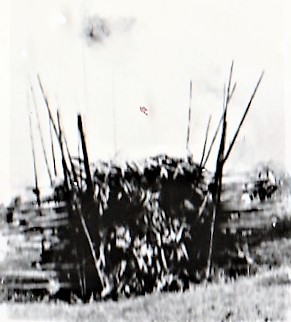
# Then more difficult negotiations, brokered with help from the Sub-District Office at nearby Minj, eventually established mutually acceptable restrictions on occupation.
The bonfire of spears and arrows was the brainchild of the Tangilka leader, Muke. (below)
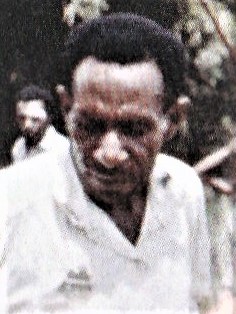
He was also prominent in persuading each clan to approve the lasting peace plan by working together to construct the ditches and drains which confirm the now permanent, perimeter.
Details of the latter were offered by his son John who secured a PhD in Archaeology at Cambridge University, lectured in anthropology at the University of Papua New Guinea and was National Advisor to the Wahgi Valley’s World Heritage Site at nearby Kuk.
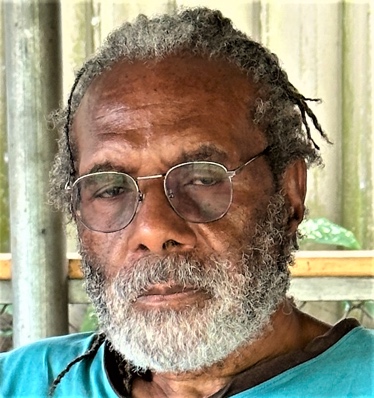
Dr John Muke
Background to the fighting
The armed, inter-clan struggle began when the Kamblika and Tangilka clans, which occupied adjacent spurs on the south side of the Wahgi, disputed ownership of a previously undeveloped section land that lay between them.
Both clans had been contacted by Australians in the 1930s but exchanges did not become regular until the early 1950s when Patrol Officer Brian Corrigan (Minj Patrol No.3 1952-53) persuaded each group to come down from the steep, and easily defended, slopes where they lived and move to flatter, more fertile, vacant ground nearer the valley floor.
Open warfare between Wahgi clans was even then becoming a thing of the past so each of these groups left their mountain eyries, secret caves, and hidden war magic houses, to move onto gentler slopes where they prospered.
No deaths through tribal fighting, improved diet, and progressively better medical facilities swelled their numbers. Employment on local coffee plantations, and then income from their own coffee blocks, made each of these groups wealthy in PNG terms.
The Tangilka owned a herd of cattle and the Kamblikas collectively enjoyed two utilities. The range and economic expectations of each clan grew annually so new land was regularly drained and fenced, either for coffee stands or vegetable gardens.
Inevitably a Tangilka and a Kamblika set out to cultivate a previously unused patch of land only to discover they had earmarked the same spot on a soon-to-be disputed tract called Dong.
The situation was not immediately serious because they were able to come to a satisfactory agreement. However, clan leaders were alarmed and each raked through their collective memories.
High up in the mountains where they used to live, land boundaries were well-defined and beyond dispute. New settlement immediately below the traditional fortress areas had acquired boundaries that were mutually accepted too. But previously vacant land like Dong, which was much lower down the slope, was different.
It would have been suicide to have been seen there alone in pre-contact days and may only have been occupied in the most marginal terms during a rare lull in the almost constant confrontations when one clan’s ascendancy was unusually high.
But the need for more garden land was urgent and tensions between them began to build when other members of each clan began to move onto sections of the new block too.
Many of them may have been cousins because inter-marriage between the two groups was common. Nevertheless, the pressure increased.
The trigger was pulled in December 1971 when an older Kamblika, with memories of earlier bloodletting still in his mind, taunted a Tangilka in-law.
He told the young man he had killed his grandfather in one of many pre-contact skirmishes. “Smell this hand,” the old man said. “It took out his liver and filled his belly with stones.”
The Tangilka reacted angrily. The Kamblika fled. And after a break of more than twenty years the clans were once again at war.
Warriors in full fighting panoply paraded on opposing spurs flaunting their weapons in vocal and unmistakable demonstrations of group unity and force.
Occasionally sallies were launched cross the intervening Kilmbe valley to test each other’s strength. Towards the end of the day a bolder rush by Kamblikas brought retreating Tangilkas into arrow range and three were wounded.
This skirmishing ceased when the sun began to set but as darkness fell a Kamblika called Mond ducked through a gap in a hedge close to his house on Dong where a young Tangilka called Kos was waiting.
Mond was killed after being hacked across his back with a bush knife.
The impact was immediate. The Tangilkas, reluctant to raise the stakes by following up one death with yet another, retreated to their most easily defended village at Tumba and settled in for a siege.
They calculated that if they could resist the Kamblika’s first retaliatory attacks kiaps would intervene and stability would be restored after compensation for Mond’s death had been negotiated and paid.
Next day angry Kamblikas attacked Tumba’s lower section destroying food gardens, plundering huts, and smashing artefacts inside. They also seriously wounded one Tangilka man, left arrow heads in the flesh of others, and raped several women. If the defence had been less effective there would have been more damage, more rape, and perhaps death too.
Kiaps intervene
Kos Tai, who had given himself up before he was killed in a revenge attack, was charged with murder and remanded. He was later jailed for six years by the Supreme Court.
Fresh fighting flared on December 3rd 1972 and over the following week some warriors were arrested.
It flashed again in March 1973 and on March 27th I was sent by Minj Sub-District Office, to Tumba, and the Kamblika stronghold at Danal, with orders to defuse the situation. Readers of “The Northumbrian Kiap” will be familiar with this section of my account.
“Perhaps fifty men from each clan were arrested over the next two days, charged with riotous behaviour, and some were jailed for six months.
That calmed things a little but the Kamblikas were still keen to fight.
Councillor Muke of the Tangilkas had a plan. Life was becoming difficult because his village was under siege. He was afraid a kinsman, even himself, might be killed; coffee could not be picked, gardens could not be tended, his cattle were being used for target practice by Kamblika bowmen; and members of his clan were keen to leave overcrowded Tumba and return to their outlying hamlets.
This could only be done if the Kamblikas agreed to end hostilities. Muke’s solution was simple. Both clans would publicly burn their weapons.
“Good thinking,” I said. “Where will you do that?”
“Minj market place,” he replied.
The Kamblikas had to be persuaded. They could lose face if fighting was suspended. Weary as they were they would have still liked to level the score by killing a Tangilka. However, they too needed to revive their sagging economic affairs so eventually they agreed.
I returned to Minj and reported to the Assistant District Commissioner who thought it was a good idea. We hadn’t a clue what might happen – even if Muke’s plan would work.”
Stage one: A bonfire of spears and arrows
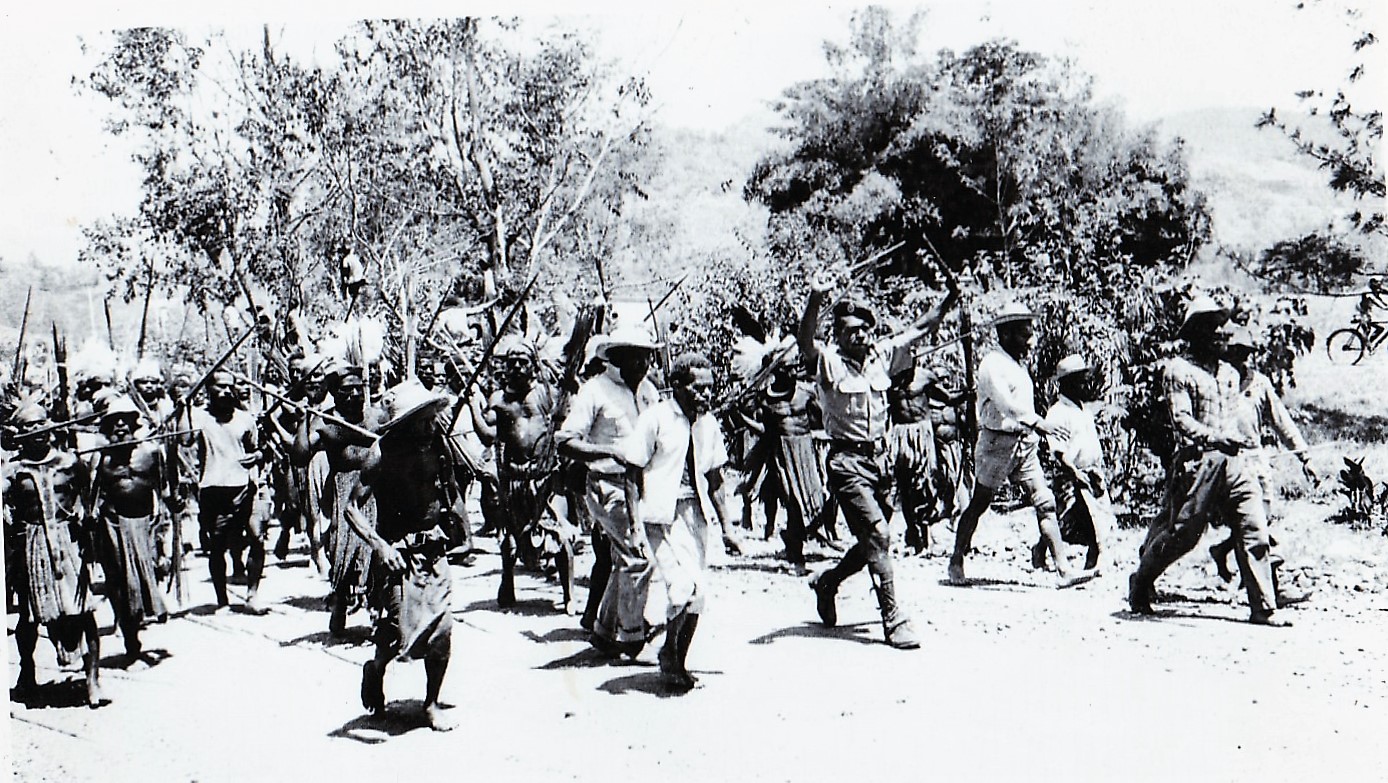
Somewhere around 200 Kamblika warriors were the first to arrive at Minj where their chanting and spear waving had attracted a large crowd.
They were led in by Senior Corporal Keogh of the Royal Papua New Guinea Constabulary. He was in charge of a small, rural police station, near the Kamblika village at Danal, had been unhappy with their decision to continue to fight the Tangilkas, and played an important role in persuading them to suspend hostilities.
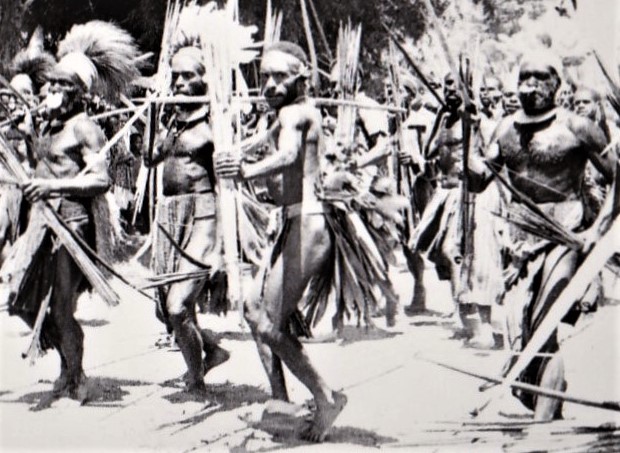
They were followed by about 200 Tangilkas.
Then the two clans poured into the market place where a large crowd had gathered.
We kiaps were relieved when they quietly sat down opposite each other.
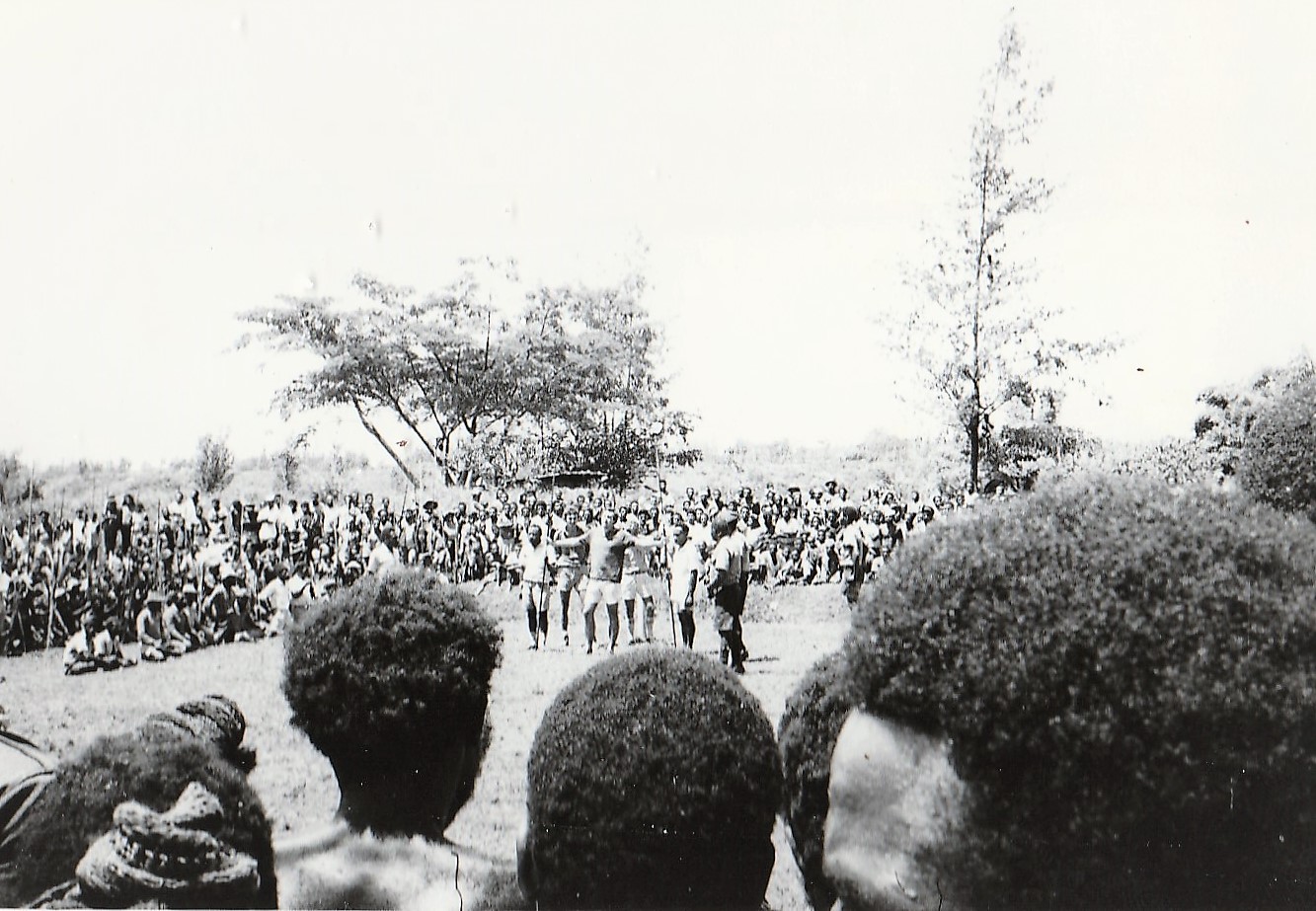
Kamblika leaders (left) sat in line with their armed warriors behind them.
Ian Douglas, the Assistant District Commissioner (centre) has taken an eight-foot Wahgi spear (kulang) in each hand. Muke, holding the shaft of one spear stands right. Councillor Koilmal of the Kamblika holding the other stands left.
The ADC praised their decision to stop fighting. And applauded their determination to destroy their weapons too.
Then Koilmal and Muke took the spears, stamped on them, and broke them in half.
A picture of this was published on the front page of the national Post Courier newspaper under the headline. “Their spears break. Their fight ends”.
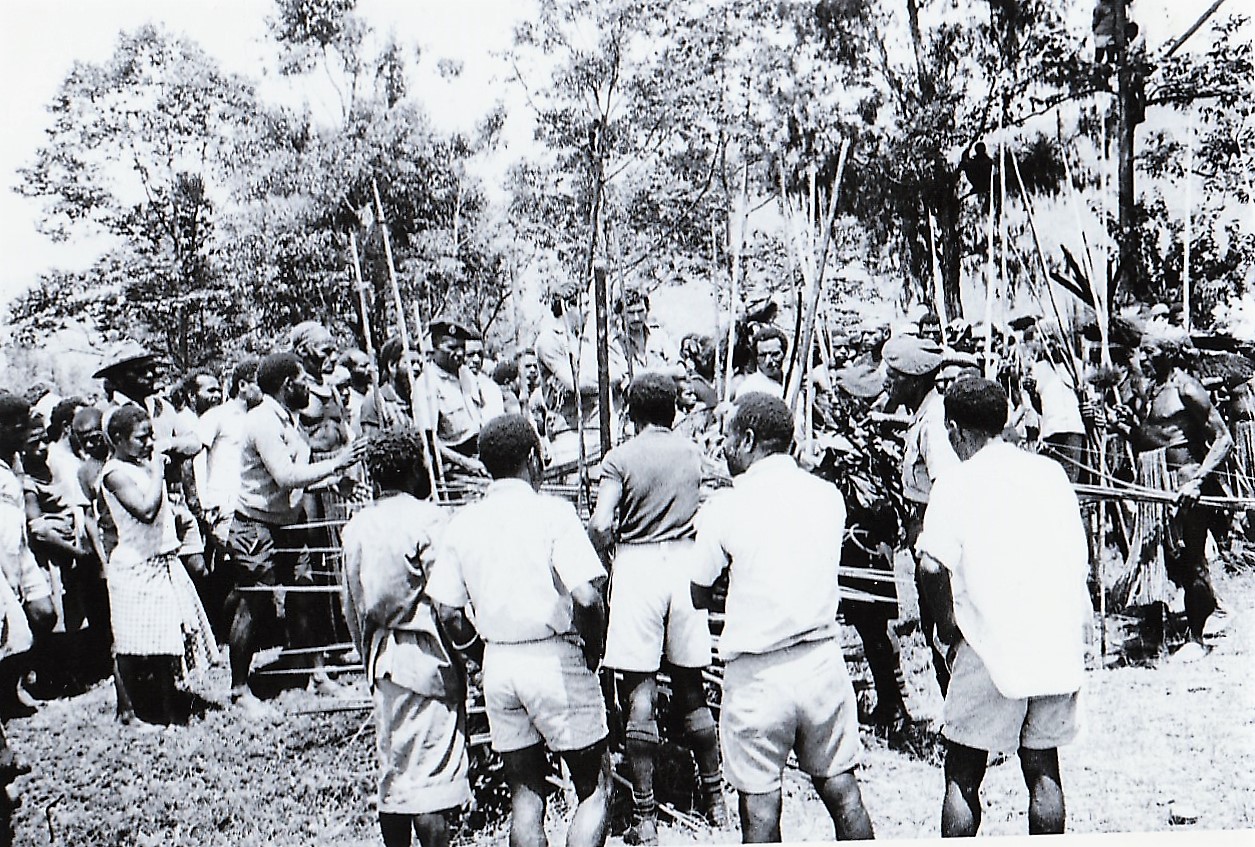
Warriors from each clan queued to add their weapons to the growing pile. Koilmal (second right) and Muke (right) watch on.
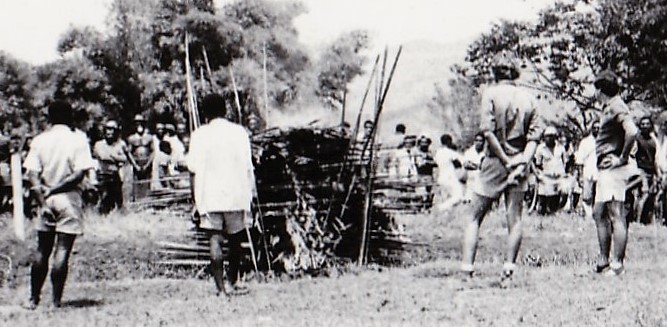
Then, each holding the same firebrand, Koilmal and Muke set the pile alight.
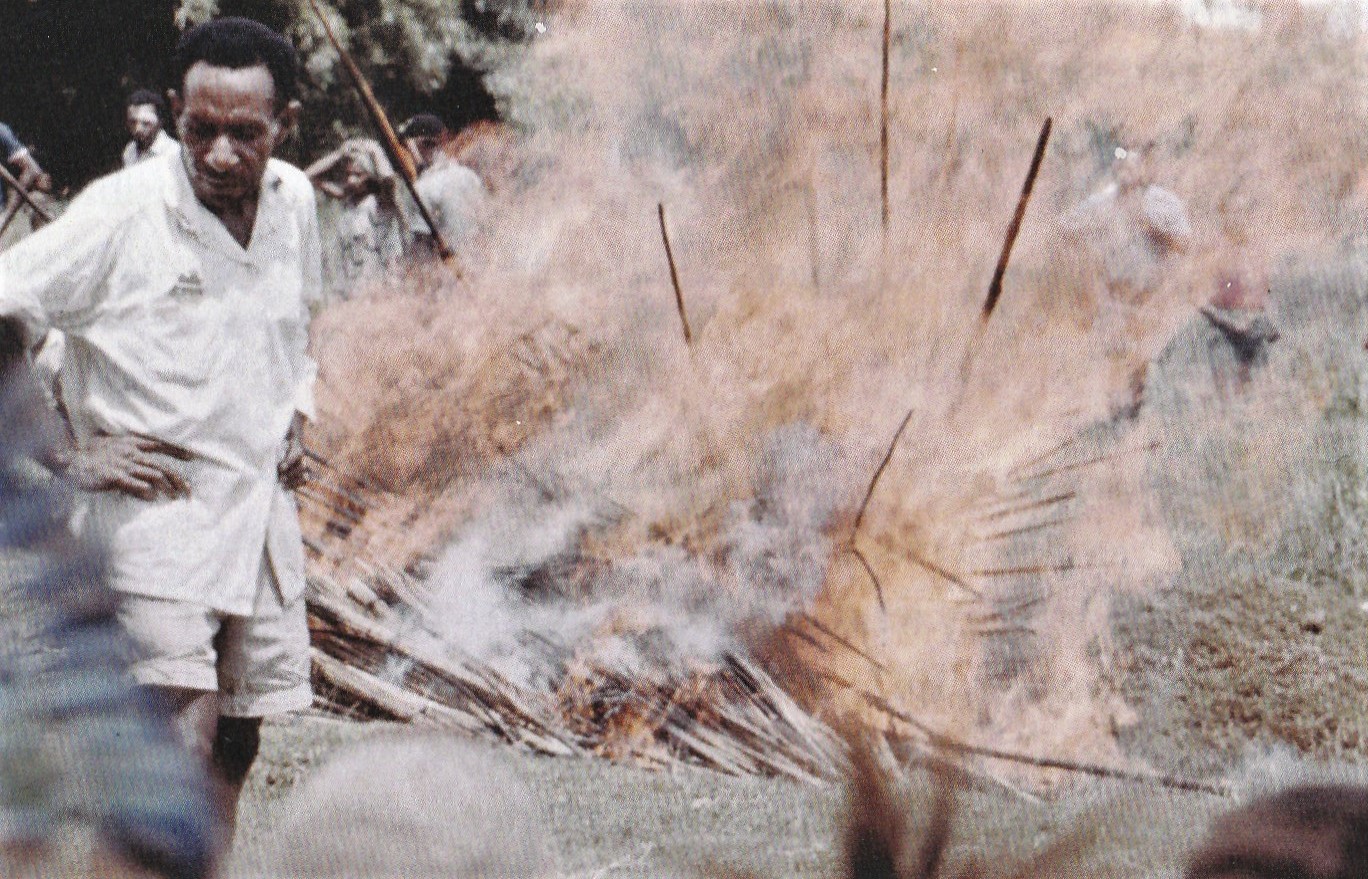
Muke winced as heat from the burning weapons spread.
Every spear, every bow, and every arrow, on the pile was burned to ash. Then each clan returned their village.
Kiaps had to ask if this was a satisfactory result? I was not sure. All that had been done was postpone further fighting, and save lives, until the destroyed weapons were replaced, or Dong could be subdivided in a way that would satisfy both clans.
The understaffed Minj office was unable to pursue the problem because another emergency erupted on the opposite side of the Wahgi the following week and attention was immediately focussed on it instead.
Just before their release, prisoners from both clans in jail at Mount Hagen were urged to concentrate on their gardens, and not on fighting, when they returned home.
But that was it. No other constructive effort to ease the crisis was made. Sub-District administration was frantic at the time and short-term crisis management was all that was possible.
We thought the clans would not fight over Dong immediately but unless they were quickly consoled by a mutually satisfactory settlement they eventually would do.
Stage two. A permanent boundary is established
Muke’s eldest son, John, describes how a permanent peace between the two clans was reached.
“A peace true between the Tangilka and Kamblika tribal people over the Dong land at the foothills of the NganNgan Ridge was eventually established.
The trouble root men were the Gokom Topei Gapam clan of Kamblika and the Beiman Kanem of the Tangilka tribe. Kos Tai of the Bor-Arim Kanem clan went to jail for the death of Mond, a member of the Kamblika’s Kugim Kup clan
I might have been in Grade 4 at the time.
The truce in the market place at Minj was one event. The other was an agreement to drain the Kilmbe River, keeping Kamblika to the east bank and Tangilka to the west.
Muke was among the leaders involved in this settlement, He provided me with the information that I outline below:
Prior to 1972, the water moving down the Kilmbe disappeared into the Danal Galngen and Dong swamplands.
The Gokom Topei Gapam and Beiman Kanem shared the Kilmbe River boundary, above the foot slopes of the Ngangan ridge, where the channel was clearly defined.
As neighbours, the two clans had extensive marriage connections. The in-laws worked together on corporate garden units and brought into cultivation land across the foot slopes of Ngangan and Danal.
In 1970, a dispute emerged between a Gokom Topei Gapam and a Beiman Kanem over a small portion of land on the west bank of Kilmbe River. It escalated into a ritualised and formalised warfare involving all the clans of the two tribes, resulting in the death of a member of the Kugim Kup clan of Kamblika tribe.
My father, Muke, actively participated in seeking a permanent solution and with help from kiaps was able to establish the following conditions:
- Extinguish all cultivation, use and occupation rights of the members of Kamblika tribe that crossed into Dong (west bank of Kilmbe, beneath Ngangan ridge).
- Extinguish all cultivation, use and occupation rights of the members of Tangilka tribe that crossed into Danal Galngen (east bank of Kilmbe River).
- Where the Kilmbe River disappeared underground, create an artificial boundary by draining a channel, in a straight line from the foot slopes of Ngangan land extending it through to the confluence of the Kilmbe and Wahgi Rivers.
- The Danal Galngen land abutting the east bank of Kilmbe is to be exclusively used and cultivated by members of the Kamblika tribe.
- The Dong land on the west bank of Kilmbe is to be exclusively used and occupied by the members of the Tangilka tribe.
The Kilmbe River was drained and the channel was the boundary that separated the Beiman Kanem (west bank) from the Gokom Topei Gapam (east bank).
At no point during this dispute settlement did members of Arim Kanem (Tangilka) claim prior occupation rights to Dong and Danal Galngen.
Neither did members of the Arim Kanem Negints Boki (Kamblika) contest the Danal Galngen and Dong land in 1972.
From that time onwards the above conditions have not been breached.”
Postcript
Muke was a remarkable man. He was born just before the first Europeans moved through the Wahgi Valley in 1933.
And would not have been married when, in 1952-53 when Patrol Officer Corrigan urged Tangilka and Kamblika leaders to move onto the huge areas of previously unoccupied land that lay below their established settlements.
Nevertheless, he reacted to these seismic social changes with astonishing flexibility and astuteness.
And when he died earlier this year, aged ninety, he left a son, John, with a Cambridge University PhD and another, Charly who was educated in both Australia and New Zealand. He too had earned a PhD and is head of the Jiwaka Education Board in his home Sub-Province.
When I knew Muke in 1972 he was the Tangilka’s Local Government Councillor, owned a herd of cattle and harvested his own coffee.
I later learned he had persuaded his clansmen to adopt coffee cultivation and had acquired, then distributed the first young plants.
Muke was personable too and would deliberately roll his eyes to soften the impact of his often far-reaching suggestions.
The picture below is of Muke with his family in 2002. He is sitting in the middle of the back row.
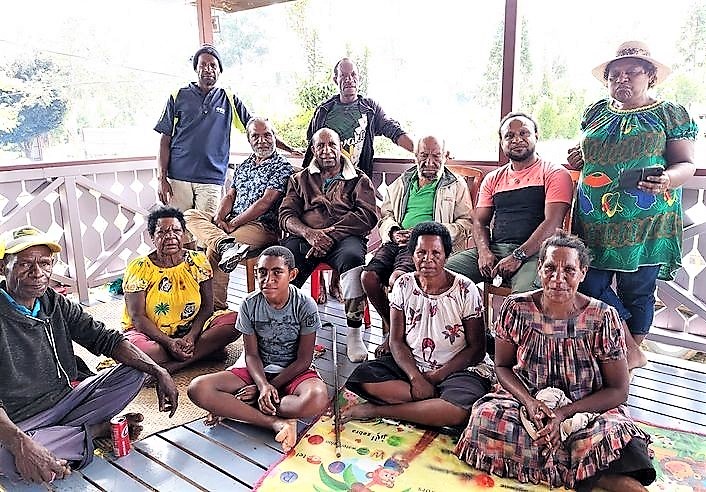
Front left to Right: Kopi Frank Muke. Ukum Muke. Junior Muke. Kuni Muke. Tope Monie.
Back left to right: Jepi Pilnge. Ombin Pilnge. Dr John Muke (sitting legs folded). Dr Charly Muke. Muke Teke. Junior Tapi Muke. Rose Muke.
(Readers of The Northumbrian Kiap will have noticed changes to the spelling of names and place names. For example Muke was “Muga” in the original text and the Kamblika clan was “Kambilika”.
These changes should not be a surprise. I cover pitfalls created by the collision between Papua New Guinean pronunciation and the 26 letter English alphabet in the book’s introduction.)